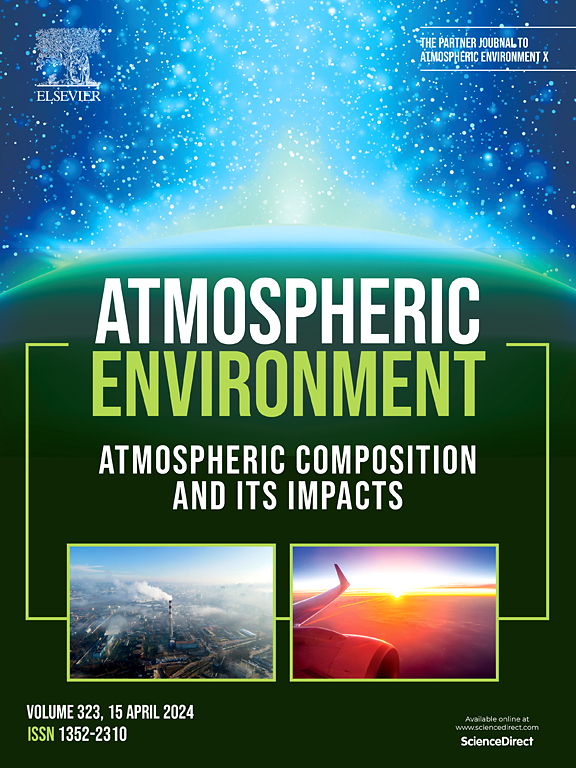求助PDF
{"title":"Human health impacts and indoor chemical reactions of VOCs from cleaning products and occupants","authors":"Rachna Bhoonah , Maxence Mendez , Alice Maury-Micolier","doi":"10.1016/j.atmosenv.2024.120846","DOIUrl":null,"url":null,"abstract":"<div><div>Occupants and indoor activities are sources of volatile organic compounds (VOCs). We propose a framework to simulate the pollutant pathway using the INCA-Indoor© model and VOC emission rates to derive dynamic concentrations, and the USEtox model to evaluate health impacts in DALYs (Disability-Adjusted Life Years). The applicability of the framework is tested on a case study, and the effect of indoor chemical reactions on health impacts is assessed. In this case study, health impacts were of 0.3 μDALY/day without and 0.4 μDALY/day (13 s/day) with indoor air chemistry (+28 %) out of which 12 % were linked to occupant breath and skin emissions. Cleaning activities led to the highest impacts without chemical reactions (terpinolene, responsible for 0.14 μDALY/day), but indoor air chemistry led to high impacts linked to formaldehyde formation (0.18 μDALY/day). These reactions led to the formation of more formaldehyde, hence leading to 20% more impacts, in summer than in winter. Occupants’ contribution to CO<sub>2</sub> concentrations exceeded recommended limits under the given occupancy and ventilation scenario. Secondary organic aerosol (SOA) formation affected indoor particulate matter mass concentrations by up to a factor 1.2 and their number concentrations by up to a factor 25,000 in the presence of VOC emissions. Results of this study indicate that chemical reactions and SOA formation are important factors to consider in indoor air quality impact assessment. A larger number of activities and scenarios can be tested to improve the robustness of the conclusions, since, under different scenarios (for e.g. activities with lower emission rates) and with more complete toxicity data, these conclusions are likely to change.</div></div>","PeriodicalId":250,"journal":{"name":"Atmospheric Environment","volume":"338 ","pages":"Article 120846"},"PeriodicalIF":4.2000,"publicationDate":"2024-09-27","publicationTypes":"Journal Article","fieldsOfStudy":null,"isOpenAccess":false,"openAccessPdf":"","citationCount":"0","resultStr":null,"platform":"Semanticscholar","paperid":null,"PeriodicalName":"Atmospheric Environment","FirstCategoryId":"93","ListUrlMain":"https://www.sciencedirect.com/science/article/pii/S1352231024005211","RegionNum":2,"RegionCategory":"环境科学与生态学","ArticlePicture":[],"TitleCN":null,"AbstractTextCN":null,"PMCID":null,"EPubDate":"","PubModel":"","JCR":"Q2","JCRName":"ENVIRONMENTAL SCIENCES","Score":null,"Total":0}
引用次数: 0
引用
批量引用
Abstract
Occupants and indoor activities are sources of volatile organic compounds (VOCs). We propose a framework to simulate the pollutant pathway using the INCA-Indoor© model and VOC emission rates to derive dynamic concentrations, and the USEtox model to evaluate health impacts in DALYs (Disability-Adjusted Life Years). The applicability of the framework is tested on a case study, and the effect of indoor chemical reactions on health impacts is assessed. In this case study, health impacts were of 0.3 μDALY/day without and 0.4 μDALY/day (13 s/day) with indoor air chemistry (+28 %) out of which 12 % were linked to occupant breath and skin emissions. Cleaning activities led to the highest impacts without chemical reactions (terpinolene, responsible for 0.14 μDALY/day), but indoor air chemistry led to high impacts linked to formaldehyde formation (0.18 μDALY/day). These reactions led to the formation of more formaldehyde, hence leading to 20% more impacts, in summer than in winter. Occupants’ contribution to CO2 concentrations exceeded recommended limits under the given occupancy and ventilation scenario. Secondary organic aerosol (SOA) formation affected indoor particulate matter mass concentrations by up to a factor 1.2 and their number concentrations by up to a factor 25,000 in the presence of VOC emissions. Results of this study indicate that chemical reactions and SOA formation are important factors to consider in indoor air quality impact assessment. A larger number of activities and scenarios can be tested to improve the robustness of the conclusions, since, under different scenarios (for e.g. activities with lower emission rates) and with more complete toxicity data, these conclusions are likely to change.
清洁产品和居住者产生的挥发性有机化合物对人体健康的影响和室内化学反应
居住者和室内活动是挥发性有机化合物 (VOC) 的来源。我们提出了一个模拟污染物路径的框架,利用 INCA-Indoor© 模型和挥发性有机化合物排放率得出动态浓度,并利用 USEtox 模型以 DALY(残疾调整生命年)为单位评估健康影响。该框架的适用性在一项案例研究中进行了测试,并评估了室内化学反应对健康影响的影响。在该案例研究中,无室内空气化学反应的健康影响为 0.3 μDALY/天,有室内空气化学反应的健康影响为 0.4 μDALY/天(13 秒/天)(+28%),其中 12% 与居住者的呼吸和皮肤排放有关。清洁活动导致的无化学反应影响最高(萜品烯,导致 0.14 μDALY/ 天),但室内空气化学导致的与甲醛形成有关的影响较高(0.18 μDALY/ 天)。这些反应导致了更多甲醛的形成,因此夏季的影响比冬季高出 20%。在特定的居住和通风情况下,居住者造成的二氧化碳浓度超过了建议限值。在有挥发性有机化合物排放的情况下,二次有机气溶胶(SOA)的形成对室内颗粒物质量浓度的影响高达 1.2 倍,对其数量浓度的影响高达 25,000 倍。研究结果表明,化学反应和 SOA 的形成是室内空气质量影响评估中需要考虑的重要因素。可以对更多的活动和情景进行测试,以提高结论的稳健性,因为在不同的情景下(例如排放率较低的活动),以及在毒性数据更加完整的情况下,这些结论很可能会发生变化。
本文章由计算机程序翻译,如有差异,请以英文原文为准。


